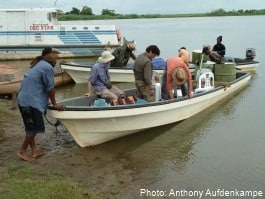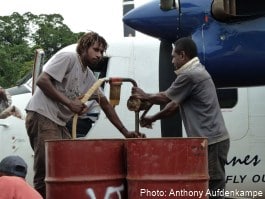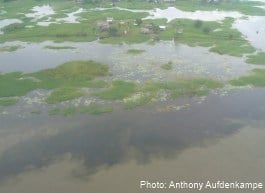This is the first article in a series on Stroud Water Research Center’s scientific expedition to the Fly River in Papua New Guinea. To read the articles in order:
- Pursuing Science Half a World Away: The Fly River in Papua New Guinea
- Unearthing Buried Treasure in Papua New Guinea
- River Are Not Pipes
By Patricia McAdams
When Anthony Aufdenkampe, biogeochemist at the Stroud Water Research Center, first envisioned working on the Fly River in Papua New Guinea, he had anticipated the loan of a promised 100-foot-long research ship, complete with laboratory, owned by Ok Tedi Mining, Ltd., in which to navigate this river. New owners revoked the offer, however—just one of countless frustrations and challenges that delayed this trip for months.
But here he was now on one of two 20-foot-long row-boat-like dinghies, motoring up the murky, crocodile-infested waters of the Fly, with four colleagues and five guides, who had never seen this part of the country before. As the guides peered into the dark, sediment-thick river, scanning anxiously for crocodiles, Aufdenkampe considered some of the other obstacles of conducting research in Papua New Guinea—like venomous snakes and plants that cause epileptic seizures if you touch them—not to mention malaria and other diseases.

But Einstein had once said, “Never lose a holy curiosity.” And Aufdenkampe was curious about the effects of the Fly River and other tropical rivers on all kinds of global processes.
The National Science Foundation (NSF) was curious too. When researching the global impact of river processes in the past, there had been considerable emphasis on studying the Amazon River.
“But the biggest rivers don’t tell the whole story,” Aufdenkampe says. “And so, in 2000, NSF launched their MARGINS Sources to Sink Program to better understand the role of tropical fresh water rivers in the overall scheme of things, selecting the Fly River as one of two international sites.”
“You can’t study global processes if you ignore the tropics,” says Rolf Aalto, geographer and geologist at the University of Exeter, in the UK, and part of this NSF research team, along with Miguel Goni from Oregon State University, Wes Lauer from Seattle University, and Michael Grenfell, Aalto’s graduate student in the UK. “Yet we know almost nothing about these rivers.”
“And that’s why Anthony and I and our colleagues hauled our gear to a swamp on the other end of the earth, because this is where the action is,” he says. “The Fly River—and hundreds of other steep tropical rivers like it—transport and bury disproportionate amounts of the world’s river-borne carbon. But exactly how much remains a mystery because few have come to answer those questions. And without those answers, current global estimates of the amount of carbon processed by tropical rivers may be underestimated by a factor of two or more.”
“Few have come to answer these questions,” Aalto adds, “because it’s so challenging to work here that they can’t pull it off. The fact is that working in Papua New Guinea is easier said than done. And besides, you could end up dead.”
CHALLENGES GETTING TO THE STUDY SITE
In addition to reptiles, poisonous plants, and ruthless pathogens, the complexities of doing anything and getting anywhere are multiplied in Papua New Guinea. Even getting to the Fly River was challenging, says Aufdenkampe.
The flight from Philly to Port Moresby, Papua New Guinea, was just under 11,000 miles and consumed 24 grueling in-flight hours. “But that was the easy part,” Aufdenkampe says. “From there on it got to be fun.”
Papua New Guinea, in fact, has few roads—and none leave the capital city of Port Moresby. Instead, the primary way people with any money travel is by airplane.

“So we jumped on this little tiny airplane, which was really like a bus with wings,” says Aufdenkampe. “There was only one plane a week. How it worked is that when the plane was taking off, the crew might get a call to learn that someone had purchased a ticket in such and such a town, so they had to stop by to pick them up. Or else they had to stop to drop someone off. There were no schedules.”
“We made nine stops on the way to Obo, where we were to start working,” Aufdenkampe says, still incredulous. “Two of those stops were just for fuel, as there was a shortage of fuel at ‘major airports’ in the region. But some logging companies had fuel to sell, so we flew twice to their airstrip and people ran over to hand-pump more fuel into the plane.”
“When Anthony talks about ‘major airports’ he means that there was a grass hut with a roof on it and maybe a bench to sit on,” says Aalto grinning. “There weren’t any vending machines, though, so we couldn’t get any food or even a can of soda. In fact, we didn’t see any vending machines ever in New Guinea. And only two airports had rest rooms.”
By dusk, when his little plane finally arrived in Obo, after eight hours zigzagging across the country, a weary Aufdenkampe considered that he probably had had a glimpse of the chaos the next three weeks would likely bring. But what did that matter? He and his interdisciplinary team had come from around the world for answers and were dedicated to getting them.
FLY RIVER MORE IMPORTANT THAN THE AMAZON?

“One of the things that had motivated this current research is that, based on some simple measurements about carbon loading on the Fly River that we had made earlier, it appears as though Papua New Guinea might be more important in terms of carbon and sediment discharge than the entire Amazon River—the largest, most amazing river on earth,” Aalto says. “We don’t know this for sure because those early calculations were based on fairly limited data. But Anthony and I set out with our colleagues to demonstrate this theory with some certainty—at least in this one river.”
So what if they had no cell phone service, or electricity to recharge their batteries, and had to stay close to their first aid kit stuffed with antibiotics, should they get a scratch? Whatever hardships lie ahead would likely be balanced by the wonders of this beautiful, if rugged, country, where the air was so warm and rich and full of a hundred fragrances of the earth and flowers and fruit.
“And, as far as worrying about crocodiles, our guides were freaking out,” says Aalto. “But people worry about the wrong things. Frankly, sitting on a boat in a river filled with crocs, I don’t see as any riskier than driving on the freeway at home, so I am attentive, but calm. And besides, we had some emergency beacons. Our hope was that if we didn’t die, we could push a button on the SPOT emergency GPS transmitter we carried with us. With any luck, maybe a rescue helicopter would show up in a couple of days.”
Three weeks later, Aufdenkampe, Aalto, and the others returned safely to their homes and respective labs with hard drives full of sonar and seismic data, and about eight coolers full of water, mud and landslide samples, which they will spend months analyzing. You can accompany this team on further adventures collecting data and scientific samples in Papua New Guinea in a future Upstream article.



